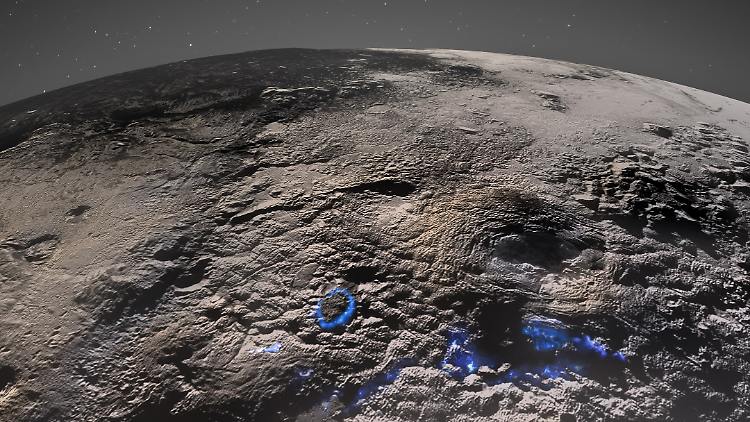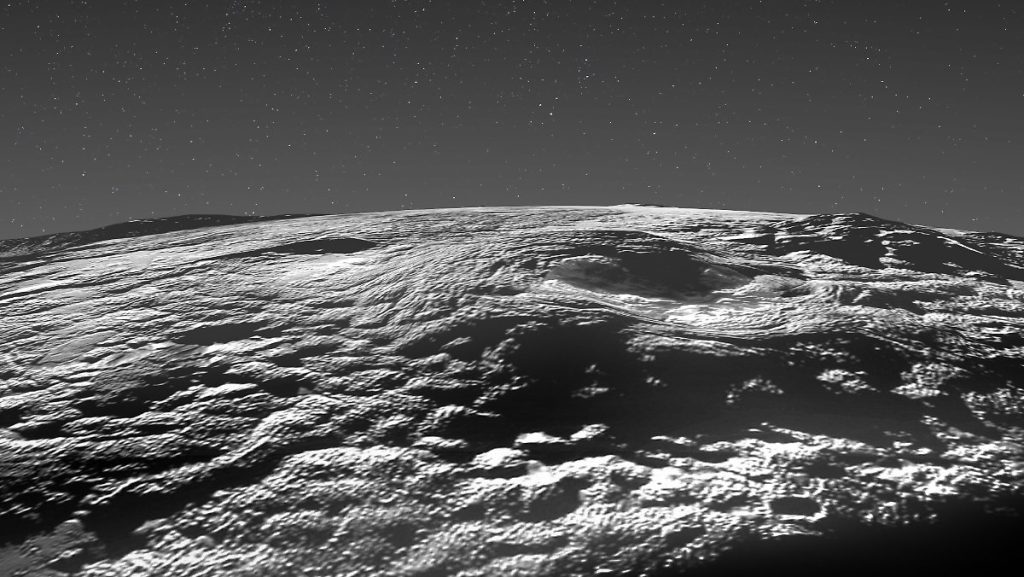View of Pluto
New Horizons photos show ice volcanoes
03/29/2022, 5:05 PM
As early as 2015, the New Horizons spacecraft captured images of the dwarf planet Pluto. New investigations of the image materials show that its surface has surprisingly modern structures – and clarifies the previously mysterious nature of the hills.
On the dwarf planet Pluto there are ice volcanoes up to seven kilometers in height, which may have been active or even active until very recently. This is the conclusion of an international research team that re-analyzed images from the New Horizons spacecraft. According to scientists, Pluto must have stored heat in its interior for longer than previously assumed or be generating more heat than expected. Nature Communications magazine.

Pluto’s surface and atmospheric haze are shown in shades of grey, and the possible performance of past volcanic processes in blue.
(Photo: NASA/Johns Hopkins University Applied Physics Laboratory/Southwest Research Institute/Isaac Herrera/Kelsey Singer)
With a diameter of 2,377 kilometers, Pluto is the largest celestial body in the Kuiper belt outside the planet Neptune. This is a region mostly covered in ice since our solar system was formed. In July 2015, the US space probe “New Horizons” flew over the dwarf planet after a journey that lasted more than nine years, and for the first time delivered high-resolution images and data of Pluto and its moons to Earth.
“Images and data have shown that there are not only ancient, cratered regions of Pluto, but also younger regions with virtually no craters,” explain Kelsey Singer of the Southwest Research Institute in the USA and colleagues. That was a big surprise to planetary researchers, because they predicted a persistently ancient surface that had not changed much since the dwarf planet formed 4.5 billion years ago. However, processes such as erosion, evaporation and deposition appear to lead to continuous surface renewal in some areas.
Kilometer thick nitrogen ice
Particularly striking is Sputnik Planitia, a 1,000-kilometre-wide plain that was probably created in the dwarf planet’s early days by the impact of a large orb. It is covered with a kilometer thick layer of nitrogen ice, which is almost completely devoid of craters. The strange hill-like structures on the southwestern edge of this plain have been a source of mystery—Singer and her colleagues have now re-examined these structures.
The researchers came to the conclusion that these are volcanic domes – however, it is not the rocky magma from the inside of the dwarf planet that penetrates the surface, but a viscous mixture of water and ice. Researchers are familiar with such “frozen volcanoes” of the icy moons of Jupiter, Saturn and Neptune. But the size and shape of the ice volcanoes on Pluto are unique, according to Singer and colleagues.
What is the source of heat that drives volcanoes?
Volcanic domes on Pluto are up to seven kilometers in height and 10 to 150 kilometers in diameter. The domes partially overlap each other and thus form larger structures. According to the team’s calculations, a total of more than 10,000 cubic meters of icy magma should have been brought to the surface from within the dwarf planet. And that until very recently, due to its location on the edge of Sputnik Planitia, some ice volcanoes must have been only a few hundred million years old.
However, all this raises the question about the source of heat driving the frozen volcanoes. Singer and her colleagues have no answer to this question. “However, the presence of these large structures shows that Pluto’s internal structure and evolution have allowed it to either store heat for longer,” say the scientists, “or generate more heat than we previously thought.”

“Total coffee aficionado. Travel buff. Music ninja. Bacon nerd. Beeraholic.”








More Stories
Coral Seeding: Artificial Insemination Makes Coral More Heat Tolerant
Fear, Anger, and Denial: How People Respond to Climate Change – Research
LKH Graz: Using radiation to combat heart arrhythmias